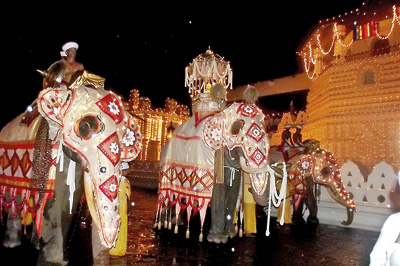A glorious sight to behold in the streets of Kandy
View(s):Rhythmical drum beats reverberate alongside vigorous dancing; pious devotees on sidewalks pay obeisance to the Sacred Tooth Relic as the Kandy Esala Perahera winds its way through the streets of the city of Kandy this week.This is the grandest week of the historic pageant with the Randoli Perahera parading the streets which makes it a relevant time to reflect on the contribution the Sacred Tooth Relic has made towards the creation of a new culture, a distinct art form, architecture, literature, music, dancing amongst many more.
 Since the Tooth Relic was brought to Sri Lanka during the reign of King Kithsirimevan (274-301CE,) the Relic had been looked upon as the state’s most precious possession. The Mahavamsa mentions that the King initiated a festival in honour of the Sacred Relic when during spring, the Relic was taken ceremonially from the Dharma Chakra built by King Devanampiyatissa where the Relic was deposited to Abhayagiri Vihara and kept there for three months for veneration. Kings of Anuradhapura according to Chinese traveller Fa-Hsien, had followed Kithsirimevan’s instructions but whether the festival continued following the fall of Anuradhapura is not known.
Since the Tooth Relic was brought to Sri Lanka during the reign of King Kithsirimevan (274-301CE,) the Relic had been looked upon as the state’s most precious possession. The Mahavamsa mentions that the King initiated a festival in honour of the Sacred Relic when during spring, the Relic was taken ceremonially from the Dharma Chakra built by King Devanampiyatissa where the Relic was deposited to Abhayagiri Vihara and kept there for three months for veneration. Kings of Anuradhapura according to Chinese traveller Fa-Hsien, had followed Kithsirimevan’s instructions but whether the festival continued following the fall of Anuradhapura is not known.
In Kandy, the Esala Perahera had originally been a procession by the four Hindu Dewalas with no participation of the Dalada Maligawa. Due to a decline of the Buddhist Sasana, the king of Kandy – Kithsiri Rajasinghe in 1775AD had invited Buddhist monks from Siam to restore Upasampadha of Bhikkhus(ordination). They had expressed surprise on finding a purely Hindu festival being conducted in the capital city. King Kithsiri Rajasinghe following their advice, ordered for the Sacred Tooth Relic to head the procession of the four Dewalas from which year began the Esala Perahera headed by the Dalada Maligawa as we know of it now.
Over the years, we see a development of political significance as the Dalada became the object that legitimized the sovereignty of the ruler. Thus, for veneration and for the protection of this priceless Relic, it was enshrined in the Dalada Maligawa built in close proximity to the Royal Palace. History records that during invasions when the King fled the capital, he took the Relic with him to prevent it falling into enemy hands and thus depriving him of his sovereignty. Besides, whenever the capital city shifted, the Tooth Relic was taken along with the sovereign and as a result, we find remnants of Dalada Maliga in many past capitals -from Anuradhapura, Polonnaruwa, Dambadeniya, Yapahuwa, Kurunegala,Gampola to Kotte. However, the Relic was kept hidden in temples during times of political unrest.
When Vimaladharmasuriya1 (1591-1604CE) founded the city of Sirivaddhana (Kandy), the Chulavamsa says “he reflected where the Tooth of the Enlightened One could be. And when he heard it was in the Labujagama Vihara, he rejoiced greatly from where he fetched it in order to venerate it day by day in his own fair town. And to dedicate a ritual to it, the wise (prince) had a two storeyed superb Relic Temple erected on an exquisitely beautiful piece of ground in the neighbourhood of the royal palace. Here he placed the Tooth and in lasting devotion brought offerings to it.”
Kandy thus has become the location of the Dalada Maligawa over five centuries ago and the presence of the Tooth Relic in Kandy made way for a religious awakening, with religious rites, rituals and ceremonies associated with the worship of the Dalada Relic practised once again. Further, it made way for the birth of specialized forms of arts, paintings, performing arts, architecture, traditions, in fact a whole new culture of a distinct character.
Built on a terraced landscape, the Dalada Maligawa which was part of the Royal Palace of the Kings of Kandy period, had courtyards at different levels and a moat around it with a draw bridge. After Vimaladharmasuriya constructed it and enshrined the Tooth Relic, the Kings who followed added ornamentations and embellishments and the monument with the octagon(Patthirippuwa) and the shimmering “Great” Lake below it. The white “valakulubamma” (the cloud wall) encircling the Lake, has long been the showpiece of the hill capital.
In the Dalada Maligawa, with the Diyawadana Nilame as the custodian of the Sacred Tooth Relic and under the close supervision of the two main Buddhist Viharas – Asgiriya and Malwatte, the age old religious rites and rituals, practised in veneration of the Sacred Tooth Relic continue unbroken.
What however, attracts thousands of viewers to Kandy every year is the Dalada Perahera – Sri Lanka’s grandest pageant where vibrantly diverse art forms are performed by hundreds of artistes thus creating a unique culture which has brought a stature unparalleled to Kandy. Elephants have been an integral part of Lankan culture and the caparisoned elephants walking with measured steps, is indeed an endearing sight.
The highpoint of the pageant however is the Maligawa tusker, gloriously dressed and majestically walking warming the hearts of the devotees. His vital function is to carry the golden casket which holds the Sacred Tooth Relic. According to history, the Tooth Relic had been in the beginning, carried in the Perahera by the tusker until such exposure was considered to be risky.


